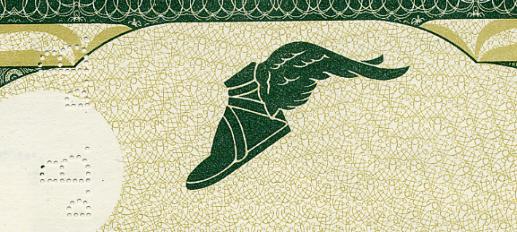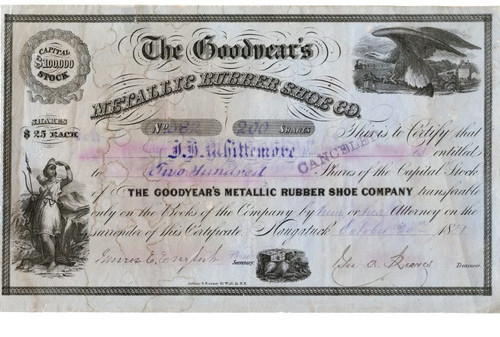Beautiful engraved specimen certificate from the Goodyear Tire & Rubber Company printed in 1960. This historic document was printed by Druk De Bussy Company and has an ornate border around it with a vignette of the company logo. 53 coupons attached on right side. 
Certificate Vignette Goodyear Tire and Rubber Company was founded in 1898 by Frank Seiberling. Today it is the third largest tire company in the world after Bridgestone and Michelin. Goodyear manufactures tires for automobiles, race cars, airplanes, and heavy machinery. In addition it makes rubber hoses, shoe soles, and parts for electric printers. The company has also been extensively involved in the aerospace, military, and hardware technology industries. Although the company was not connected with him, it was named in honor of Charles Goodyear. Goodyear invented vulcanized rubber in 1839. The first Goodyear Tires became popular because they were easily detachable and low maintenance. Goodyear is famous throughout the world because of its Goodyear blimp. The blimp came from Goodyear's attempts to enter the Aircraft and Aerospace industries after World War II. Today it is one of the most recognizable advertising icons in America. The first Goodyear factory opened in Akron Ohio in 1898. The thirteen original employees manufactured bicycle and carriage tires, rubber horseshoe pads, and poker chips. The company grew with the advent of the automobile. In 1901 Frank Seiberling provided Henry Ford with racing tires. By 1908 Ford was outfitting his Model T with Goodyear tires. A year later Goodyear manufactured its first aircraft tire. In 1911 Goodyear started experimenting with airship design. It later manufactured airships and balloons for the U.S. military during World War I. The transport and reconnaissance capabilities that Goodyear provided contributed significantly to the Allied victory. By 1926 Goodyear was the largest rubber company in the world. Only four years earlier they were forced to temporarily cease race tire production due to competition. Nevertheless, the popularity of the Goodyear tire on the racing circuit led to a popular demand for the brand. For the next sixty years Goodyear grew to become a multinational corporation with multi-billion dollar earnings. It acquired their rival Kelly-Springfield Tire in 1935. During World War II Goodyear manufactured Corsair fighter planes for the U.S. Military. By 1956 they owned and operated a nuclear processing plant in Ohio. Sales for 1969 topped $3 billion, five years later sales topped $5 billion and it boasted operations in thirty four countries. In 1978 the original Akron plant was converted into a Technical Center for research and design. By 1985 worldwide sales exceeded $10 billion dollars. Goodyear's crown jewel was the Goodyear Aerospace Corporation, a holding that developed from the Goodyear Aircraft Company after World War II. In 1979 they designed a supercomputer for NASA's Goddard Spaceflight Center, the MPP. The subsidiary was sold in 1987 to the Loral Corp. as a result of restructuring. In 1986 The Goodyear Rubber and Tire Company was a victim of a Greenmail attack. British financier Sir James Goldsmith and his investment group Hanson purchased 11% of Goodyear stock. They threatened to take the company over unless Goodyear bought back the shares at a highly inflated price. The following year Goodyear retaliated with a massive restructuring. The company sold subsidiaries, closed plants, and tried to damage itself financially to make it an unsuitable takeover target. The plan worked and Sir Goldsmith reportedly walked away with $90 million for his efforts. The last major restructuring of the company took place in 1991. Goodyear hired Stanley Gault, former CFO of Rubbermaid inc, to expand the company into new markets. The moves resulted in 12,000 employees being laid off. On Oct. 5, 2006 the United Steelworkers Union voted to strike at a Goodyear plant in Kansas. The strike was called over a dispute about higher health care costs and the closing of a non-unionised plant in Texas. The strike lasted until Jan 2, 2007, and cost the company approximately $358 million. The US Army briefly considered invoking a clause in Taft-Hartley Act to force the employees back to work. Humvee tires are produced at the Kansas plant and there was concern that the strike would create a shortage had it continued longer than it did. 1898 -- Goodyear Founded 1901 -- Seiberling makes racing tires for Henry Ford 1908 -- Ford's Model T is outfitted with Goodyear tires 1909 -- 1st aircraft tire 1911 -- 1st airship envelope 1917 -- made airships & balloons for the U.S. military during World War I 1919 -- tires on the winning car at the Indianapolis 500 1926 -- world's largest rubber company 1935 -- acquired Kelly-Springfield Tire 1956 -- Goodyear-operated U235 atomic processing plant opens in Ohio 1958 -- enters racing to counter "stodgy" image 1967 -- Goodyear introduces the Polyglas tire, one of the first wide-tread bias-belted fiberglass tires, which along with similar tires from competitors such as the Firestone Wide-Oval would become regular equipment on 1970 to 1974 models, which would be superseded by radial tires beginning in 1975. 1974 -- sales reach $5 billion 1978 -- Akron plant converted into Technical Center for R&D 1984 -- worldwide sales exceed $10 billion 1986 -- Sir James Goldsmith takeover attempt 1987 -- massive restructuring 1987 -- completion of the California - Texas "All American" oil pipeline 1994 -- "electronic store" opened on the CompuServe network 1999 -- Goodyear Dunlop enters joint venture with Sumitomo Rubber 2006 -- end car tire production in the UK, closure of the Washington plant Goodyear Tire is structured into the following units: Asia Pacific Region Pierre E. Cohade, President European Union Business Arthur de Bok, President Latin American Region Eduardo A. Fortunato, President Eastern Europe, Middle East & Africa Business Jarro F. Kaplan, President Consumer Tires North American Tires Lawrence D. Mason, President North American Tire Richard J. Kramer, President Engineered Products Timothy R. Toppen, President Current members of the board of directors of Goodyear Tire are: James C. Boland, John G. Breen, Gary D. Forsee, William J. Hudson Jr., Steven A. Minter, Denise M. Morrison, Rodney O'Neal, Shirley D. Peterson, G. Craig Sullivan, Thomas H. Weidemeyer, Michael R. Wessel, W. Alan McCollough, and Robert J. Keegan (chairman). Robert J. Keegan is also the chief executive officer of the company (since 2002), succeeding Samir G. Gibara. History from Wikipedia and OldCompanyResearch.com.
About Specimens Specimen Certificates are actual certificates that have never been issued. They were usually kept by the printers in their permanent archives as their only example of a particular certificate. Sometimes you will see a hand stamp on the certificate that says "Do not remove from file". Specimens were also used to show prospective clients different types of certificate designs that were available. Specimen certificates are usually much scarcer than issued certificates. In fact, many times they are the only way to get a certificate for a particular company because the issued certificates were redeemed and destroyed. In a few instances, Specimen certificates we made for a company but were never used because a different design was chosen by the company. These certificates are normally stamped "Specimen" or they have small holes spelling the word specimen. Most of the time they don't have a serial number, or they have a serial number of 00000. This is an exciting sector of the hobby that grown in popularity over the past several years.

Certificate Vignette
About Specimens Specimen Certificates are actual certificates that have never been issued. They were usually kept by the printers in their permanent archives as their only example of a particular certificate. Sometimes you will see a hand stamp on the certificate that says "Do not remove from file". Specimens were also used to show prospective clients different types of certificate designs that were available. Specimen certificates are usually much scarcer than issued certificates. In fact, many times they are the only way to get a certificate for a particular company because the issued certificates were redeemed and destroyed. In a few instances, Specimen certificates we made for a company but were never used because a different design was chosen by the company. These certificates are normally stamped "Specimen" or they have small holes spelling the word specimen. Most of the time they don't have a serial number, or they have a serial number of 00000. This is an exciting sector of the hobby that grown in popularity over the past several years.








